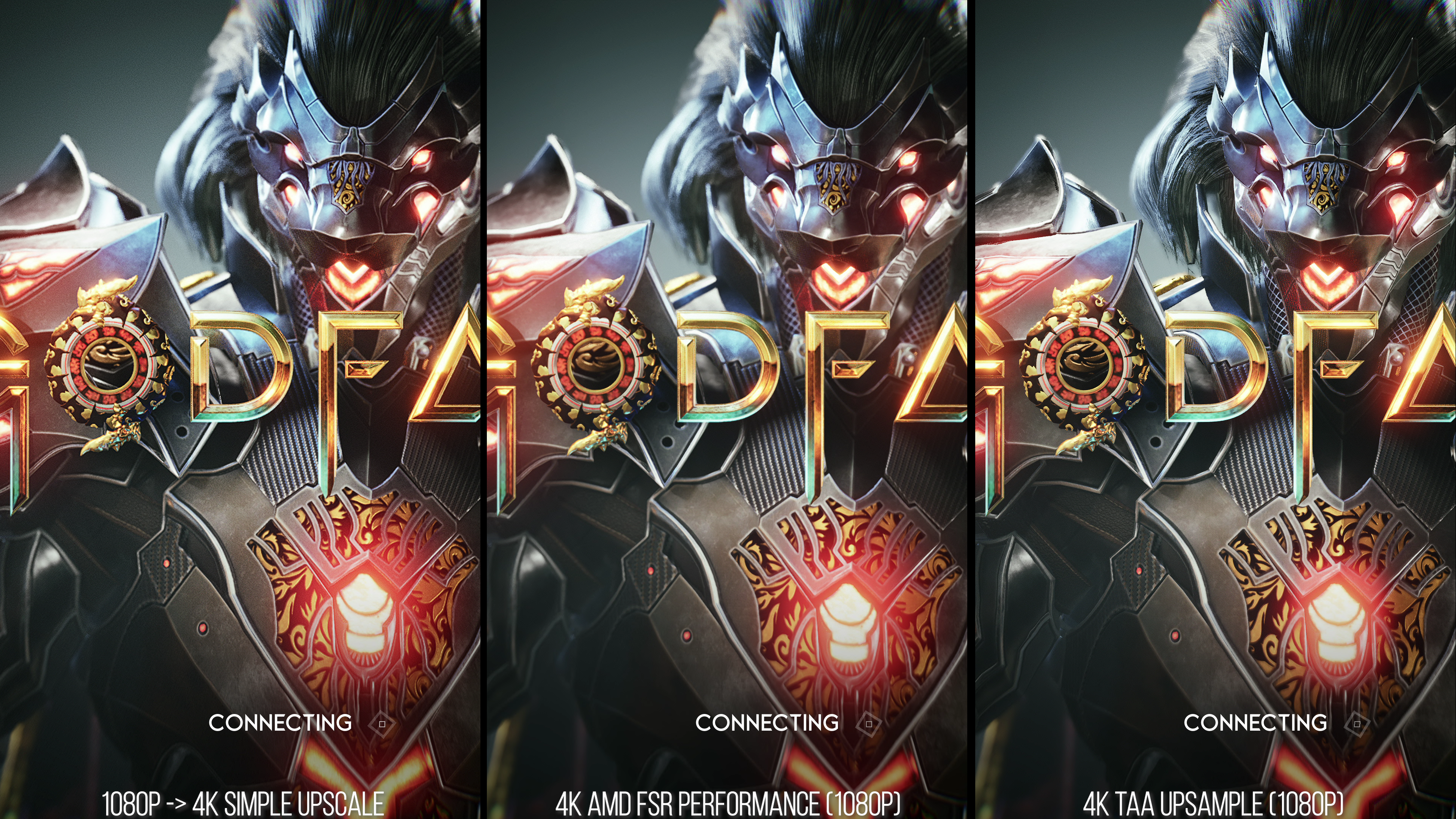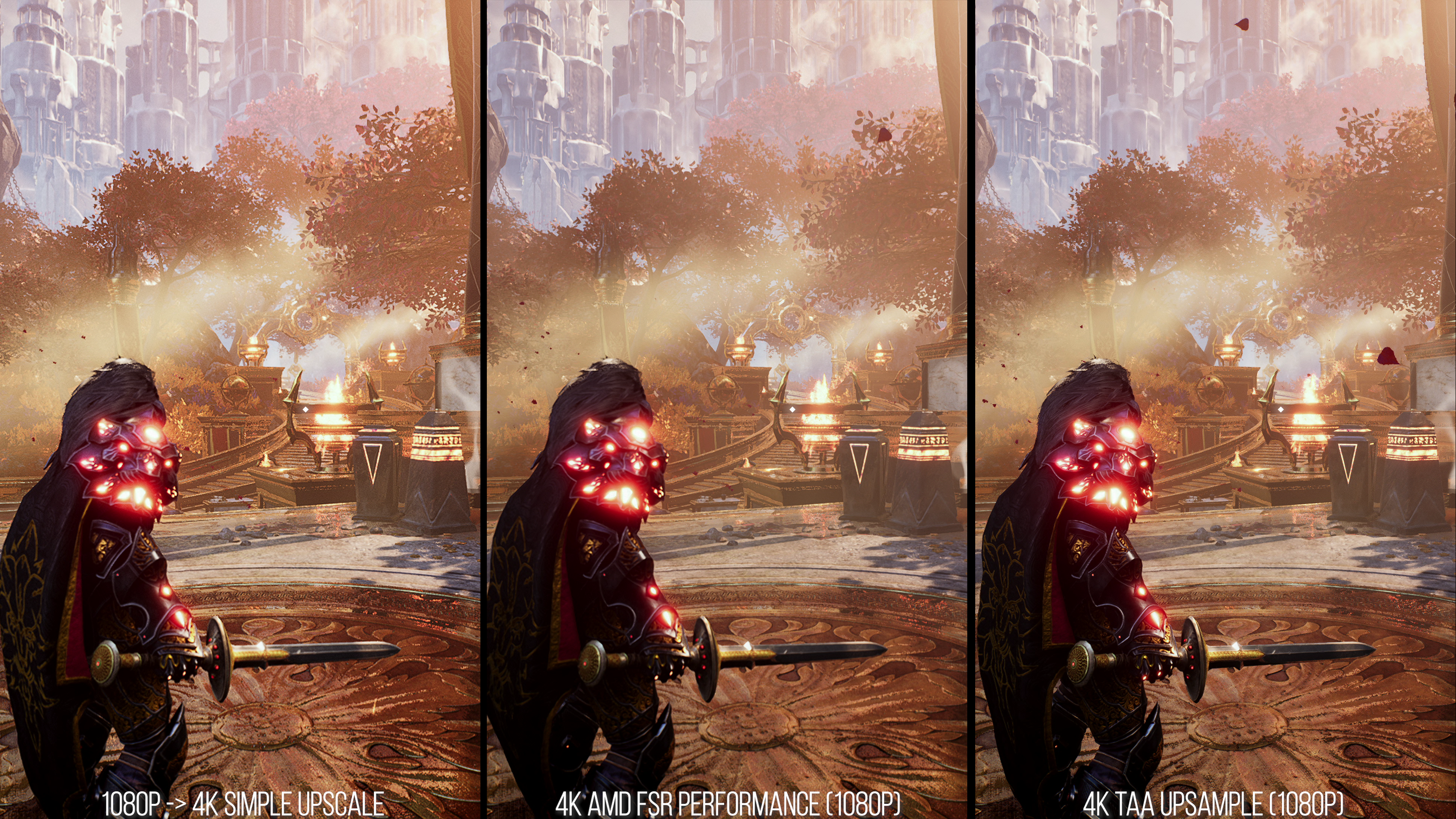Yes, this is what I meantI think @nAo means temporal artefacts, like pixel popping, shimmer, specular aliasing, etc. Without TAA a modern game would be pretty darn aliased in ways a spatial upscaling filter cannot solve (it does not even begin to tackle that), unless it was also spatially supersampled as well.
Install the app
How to install the app on iOS
Follow along with the video below to see how to install our site as a web app on your home screen.
Note: This feature may not be available in some browsers.
You are using an out of date browser. It may not display this or other websites correctly.
You should upgrade or use an alternative browser.
You should upgrade or use an alternative browser.
D
Deleted member 90741
Guest
Nick Thibiroz (Managing AMD's GPUOpen initiative) said the choice of spatial upscaler is simply because of lower performance overhead as their target is it to run across a wide range of HW (read last gen consoles/APUs)
There will be other forms of FSR which targets different range of HW using different set of algorithms.
There will be other forms of FSR which targets different range of HW using different set of algorithms.
NThibieroz
Newcomer
I don't remember explicitly saying this in the podcast, but certainly one of the goals for FidelityFX Super Resolution was low performance overhead in addition to cross-platform compatibility (including older GPUs), ease of integration and open source access.Nick Thibiroz (Managing AMD's GPUOpen initiative) said the choice of spatial upscaler is simply because of lower performance overhead as their target is it to run across a wide range of HW (read last gen consoles/APUs)
Looking forward to seeing this algorithm progressI don't remember explicitly saying this in the podcast, but certainly one of the goals for FidelityFX Super Resolution was low performance overhead in addition to cross-platform compatibility (including older GPUs), ease of integration and open source access.
D
Deleted member 90741
Guest
I was listening only, while doing something else, a bit hard to capture the speaker vividly but glad you stated the goals of FSR nevertheless.I don't remember explicitly saying this in the podcast, but certainly one of the goals for FidelityFX Super Resolution was low performance overhead in addition to cross-platform compatibility (including older GPUs), ease of integration and open source access.
I enjoyed the podcast, very candid and professional. The hosts included.
D
Deleted member 2197
Guest
Its more a TAA/U competitor then a DLSS one. For esports and mobile this has a future and it seems AMD is pushing towards that with this tech. Next year's galaxy S22 is supposed to have some sort of RDNA gpu in it.
If true why would competitors (Nvidia, Intel) help provide development resources to work on FSR when there is little benefit outside pc implementations? Especially if they have better alternatives that suit their primary platforms?
It may be open source but the attraction of cross platform (mobile, console, pc) primarily benefits AMD primarily though increased hardware sales. And like Radeon Rays, there is no guarantee of becoming closed after years of open source development.
In marketing talk, yes it's similar to TAAU/DLSS.Its more a TAA/U competitor then a DLSS one. For esports and mobile this has a future and it seems AMD is pushing towards that with this tech. Next year's galaxy S22 is supposed to have some sort of RDNA gpu in it.
Although a direct comparison what it is intended to do, would be the ingame resolution scalers. (Render in low resolution and then spatial only upscale to target resolution.)
As it's two part scaling solution it's in a way similar to what FXAA4 was going to be. (Or what we thought it would have been.)
Find edges, write result to larger buffer using the edge data.
Although unlike FXAA4 FSR uses antialiased buffer as a source and it can approximate the subpixel location of the edges from sources AA gradients and thus doesn't cause jittering similar to polygons without sub-pixel correction to those edges. (Also it doesn't have AA component.)
So it shouldn't look good without AA in source, perhaps working better on diagonal areas. (In a way similar to how Ps3 upscaler worked on Ps1 and Ps2 games.)
Enabling TAAU disables depth of field. Happens in Kingshunt, and from these screenshots it appears that it happens in Godfall as well.
These images are also very suspect to me, as I've been testing Kingshunt and Dota 2 all day today to characterize FSR, and I would NOT expect these results. DF's testing is whack.
These images are also very suspect to me, as I've been testing Kingshunt and Dota 2 all day today to characterize FSR, and I would NOT expect these results. DF's testing is whack.
It does not happen in God Fall at all. You can see that it does not based on the very first image that I posted of the menu 3d rendering.Enabling TAAU disables depth of field. Happens in Kingshunt, and from these screenshots it appears that it happens in Godfall as well.
These images are also very suspect to me, as I've been testing Kingshunt and Dota 2 all day today to characterize FSR, and I would NOT expect these results. DF's testing is whack.
I will have a quality mode screenshot comp as well.I have an information from Vanguard program member that there is new FSR 1.x version in the works
@Dictator Can we also have FPS counter and other FSR presets in those screenshots comparisons?
Godfall really seems to have quite bit of grain applied before FSR, quite stark difference in result.
Is it possible to disable grain?
I suspect the thick edges would look bit better without it. (Dirty edge gradients and so on.)
TAAU obviously has huge advantage though.
DoF is still there, but the area where camera is sharp is changed. (UE DoF has had problems where it changes with resolution and so on.)Enabling TAAU disables depth of field. Happens in Kingshunt, and from these screenshots it appears that it happens in Godfall as well.
These images are also very suspect to me, as I've been testing Kingshunt and Dota 2 all day today to characterize FSR, and I would NOT expect these results. DF's testing is whack.
I will try and make it so that I disable every single post effect that is not TAA or sharpening for the comparison I add to the website. So that people see everything as 100% the exact same between versions and so that they can honestly stop coming up with new ways to say "this testing is invalid" as that is what I imagine will happen if I do not do that.Godfall really seems to have quite bit of grain applied before FSR, quite stark difference in result.
Is it possible to disable grain?
I suspect the thick edges would look bit better without it. (Dirty edge gradients and so on.)
TAAU obviously has huge advantage though.
DoF is still there, but the area where camera is sharp is changed. (UE DoF has had problems where it changes with resolution and so on.)
Forced TAAU being broken in one of the tested games just goes to show that adding TAA/TAAU in games is not an automated process even with engine support. Seeing as how a big corporation like Epic Games can't make adding TAA/TAAU transparent enough, one has to really wonder if the others are truly getting it right ...
Disabling the post effects pipeline just because it doesn't play nicely with temporal sampling techniques is a somewhat depressing conclusion for the developers ...
Disabling the post effects pipeline just because it doesn't play nicely with temporal sampling techniques is a somewhat depressing conclusion for the developers ...
Forced TAAU being broken in one of the tested games just goes to show that adding TAA/TAAU in games is not an automated process even with engine support. Seeing as how a big corporation like Epic Games can't make adding TAA/TAAU transparent enough, one has to really wonder if the others are truly getting it right ...
Disabling the post effects pipeline just because it doesn't play nicely with temporal sampling techniques is a somewhat depressing conclusion for the developers ...
Whoa you are jumping to many conclusions there with no data to back it up.
Sweet, it should interesting.I will try and make it so that I disable every single post effect that is not TAA or sharpening for the comparison I add to the website. So that people see everything as 100% the exact same between versions and so that they can honestly stop coming up with new ways to say "this testing is invalid" as that is what I imagine will happen if I do not do that.
And yes, that sounds like a pain.
TAAU DoF difference may not have anything to do with temporal sampling.Forced TAAU being broken in one of the tested games just goes to show that adding TAA/TAAU in games is not an automated process even with engine support. Seeing as how a big corporation like Epic Games can't make adding TAA/TAAU transparent enough, one has to really wonder if the others are truly getting it right ...
Disabling the post effects pipeline just because it doesn't play nicely with temporal sampling techniques is a somewhat depressing conclusion for the developers ...
Just that there is new place/location for scaling and UE just doesn't adjust the math properly.
Last edited:
Whoa you are jumping to many conclusions there with no data to back it up.
I don't think I am. There are already recent UE4 games shipping without TAAU ... (getting smart with console commands might come back to bite you)
Similar threads
- Replies
- 7
- Views
- 3K
- Replies
- 41
- Views
- 6K
- Replies
- 574
- Views
- 53K
- Replies
- 31
- Views
- 4K




